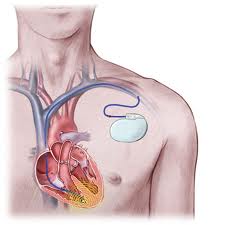The Heart's Electrical System
The heart's electrical system causes the heart to beat, controls the heart rate (the number of beats per minute). Given an electrical signal, the upper heart chambers (atria), contract (pump) and then relax and then passes down the separating tissue to the ventricles, causing them to contract and pump blood to the body. After the ventricles complete contracting, the electrical impulses cease and the heart muscle relaxes.
Sudden cardiac arrest (SCA)
Sudden cardiac arrest is the unexpected collapse of a casualty whose heart has ceased to function due to an electrical malfunction of the heart, disrupting that muscle's normal rhythm. SCA is not a heart attack, which is a problem with the plumbing of the heart.
In a heart attack one or more of the arteries delivering blood to the heart is blocked, so oxygen in the blood cannot reach the heart muscle and the heart muscle is damaged. During sudden cardiac arrest, the electrical signals to the pump suddenly become erratic. The ventricles may flutter or quiver (ventricular fibrillation) and so blood is not delivered to the body. Blood flow to the brain is reduced and the casualty loses consciousness. Death will follow unless emergency treatment is begun.
Cardiac arrest is closely linked with sudden chest pain. During SCA the heart twitches irregularly, most often in adults due to ventricular fibrillation (VF) and cannot pump oxygenated blood efficiently to the brain, lungs and other organs. The casualty quickly stops breathing and loses consciousness.
 There are no prior symptoms of sudden cardiac arrest. However, risk factors have been identified as increasing the potential for sudden cardiac arrest. Risk factors include:
There are no prior symptoms of sudden cardiac arrest. However, risk factors have been identified as increasing the potential for sudden cardiac arrest. Risk factors include:
- Family history of sudden cardiac arrest
- Heart failure (heart pumps poorly)
- History of heart rhythm disorders
- Previous heart attack
- Previous sudden cardiac arrest episode
Successful resuscitation of such a casualty depends on quick decisive action taken in sequence, like the links in a chain.
Defibrillation pads
Defibrillation pads are soft, thin foam about the size of a hand. The pads are adhesive and have a layer of gel which helps pick up the electrical signals. They normally have a cable attached to each pad. Normally a set is packaged in a special sealed pouch. As they can 'dry out', they have an expiry date printed on the package.
Pads must adhere firmly to the chest, so it is important to press the pads on firmly, including the edges of the pads. Pads may not stick securely for several reasons. These include moisture and excessive hair on the chest. Moisture can be wiped away with a towel or cloth. You may need to clip or shave excessive hair off the chest around the pad area.
Each AED manufacturer will have the instructions for applying the pads on the pad packaging and on the pads themselves. Follow these instructions as they will apply directly to the AED being used.
Procedure for administering an AED
- Send someone for the AED if not already done
- Ensure safety - if two rescuers are present, assign tasks for each rescuer
- Turn on the AED
- Attach the electrode pads - if multiple rescuers, continue CPR while the pads are attached
- Follow the voice/visual prompts of the AED
- Ensure nobody touches the casualty while the AED is analysing the rhythm If a shock is indicated:
- Ensure nobody touches the casualty
- Say "stand clear"
- Check nobody is touching the casualty
- Push the shock button as directed - fully-automatic AEDs will deliver the shock automatically
- Continue to follow the voice/visual prompts of the AED If no shock is indicated:
- Immediately resume CPR using a ratio of 30 compressions to 2 rescue breaths.
- Continue to follow the voice/visual prompts of the AED
Safety
An AED, just like any electrical appliance, has safety precautions to prevent injury. The AED operator is responsible for keeping all persons from touching the casualty when a shock is delivered.
- State a 'clear' message. For example, say loudly "don't touch the casualty" or "stand clear"
- Look to ensure that no one is touching the casualty before pressing the shock button

Beware of implants
If you are aware that a casualty has an electronic pacemaker or cardioverter implanted under the skin, ensure that the AED chest pad is positioned at least 1Ocm away from the pacemaker.
Ensure the pads are not placed over a Glyceryl Trinitrate patch (GTN).
Beware of gaseous or oxygen-rich environments
Defibrillators can cause sparks. If using oxygen to supplement resuscitation, ensure there is no concentration of oxygen around the casualty's chest. Ensure there is no build-up of other gases around the scene.
Beware of water
Do not use an AED if the casualty or the surroundings are saturated with water. Water is an effective transmitter of electricity and the shock may be transmitted to the AED operator.
Separate the electrodes
Don't put or place the electrodes or connected pads together or allow them to touch if the AED is 'on'. This may complete a circuit and cause an electrocution. The AED should never be connected to anyone other than a casualty in cardiac arrest, nor should an AED be attached to a person for training or demonstration purposes. A sign should be used to indicate the location of the AED.